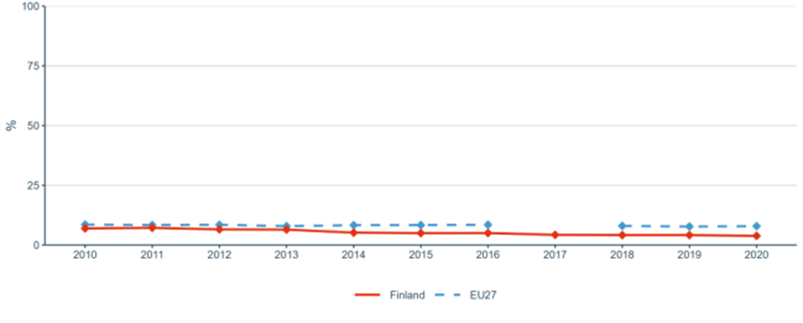ERA Country Report 2023
Finland
Edited by Haya Al-Ajlani (Ecorys)
as part of ‘Development of the ERA Scoreboard, the ERA Dashboard and the Regular Reports’ project for the European Commission, Directorate-General for Research and Innovation under Framework Contract N° 2018/RTD/A2/OP/PP-07001-2018 Lot 2 (EDAR)
Click here to download this country report![]()
- Table of contents
-
ERA Country Report 2023: Finland
1. National context
1.1. Overview of the ERA policy agenda implementation
1.2. Policy context
2. Assessment of the Implementation of the ERA Policy Agenda and ERA Priorities
2.1. ERA Priority 1: Deepening a truly functional internal market for knowledge
2.2. ERA Priority 2: Taking up together the challenges posed by the twin green and digital transition and increasing society’s participation in the ERA
2.3. ERA Priority 3: Amplifying access to research and innovation excellence across the Union
2.4. ERA Priority 4: Advancing concerted research and innovation investments and reforms
3. Country-specific drivers and barriers
4. Final remarks
5. Bibliography
6. Annexes
6.1. Annex 1: Graphs
ERA Country Report 2023: Finland
|
Key takeaways:
|
1. National context
1.1. Overview of the ERA policy agenda implementation
According to the European Innovation Scoreboard 2023, Finland is considered an innovation leader, demonstrating a performance of 134.3% of the EU average. Currently, the Finnish innovation growth at 8.5% exceeds the EU average. Finland´s commitment towards R&I is demonstrated with the country´s commitment to the ERA Priorities. Finland has committed to 13 actions of the ERA Policy Agenda.
The country´s engagement is supported with some key policies at a national level such as the Recovery and Resilience Plan. Similarly, Business Finland and the Research Council of Finland both have ongoing projects that will end by 2023 promoting green initiatives and R&I for sustainable and digital growth. Scientific research is further amplified under the Finnish Research Impact Foundation that aims to enhance public-private collaborations and stimulating synergies between the industrial and academic sectors. Overall, Finland has developed several initiatives related to the specific ERA actions. This report sheds light on key initiatives.
1.2. Policy context
Finland's research and innovation strategy is structured around key institutions such as the Prime Minister’s Research and Innovation Council (RIC). The OECD STIP Survey has emphasised the objective to centralise the role of the RIC in coordinating research and innovation policies and to enhance collaboration across administrative branches and sectors. The Act on government R&D funding, established to reinforce this vision, sets the government's contribution to R&D funding at 1.2% of GDP by 2030.
In March 2023, the Parliamentary RDI working group introduced the multiannual R&D funding plan. This plan outlines policy development requirements and highlights the importance of the Research and Innovation Council in setting strategic priorities, which are based on global trends, environmental transition considerations and growth requirements. Finland has also integrated the 13 ERA Actions that it has committed to into its national strategies, reflected in the National RDI Roadmap and the discussions of the Parliamentary RDI Working Group.
The national intellectual property rights strategy initiated in 2022 is designed to enhance expertise in this field and address existing challenges. In 2023, the Act on government R&D funding and tax deductions were introduced to encourage SMEs to broaden their R&D endeavours. Initiatives such as Business Finland Co-Innovation, Co-Creation funding, and the Research Council of Finland’s Flagship Programme aim to support long-term RDI collaboration between public and private sectors.^
Following the parliamentary elections in April 2023, the newly elected government adhered to the multiannual R&D plan and maintained its focus on RDI, in line with the ERA policy framework.
2. Assessment of the Implementation of the ERA Policy Agenda and ERA Priorities
This chapter has two objectives: 1) It qualitatively assesses the state-of-play of the implementation of the ERA actions that Finland has committed to. The qualitative information primarily stems from the OECD STIP survey 2023, supplemented by further desk research on Finland's Research and Innovation (R&I) landscape; 2) It quantitatively assesses the country’s progress towards achieving the ERA priorities as set out on the Pact for Research and Innovation in Europe. The presented quantitative information is mainly based on the ERA Scoreboard and ERA Dashboard indicators, and covers longer-term trends since 2010. Additionally, general indicators for the overall R&I system are outlined in Table 1. More detailed information on the data and graphs can be found in Annex 1. This report will serve as a baseline for reporting in the future.
| Indicator |
Most recent EU average |
Most Recent Metric |
| Gross Domestic Expenditure on R&D (GERD) as a percentage of GDP |
2.26 (2021) |
2.98 (2021) |
| Government Budget Allocations for R&D (GBARD) as a share of GDP |
0.76 (2021) |
0.89 (2021) |
| Researchers (in full-time equivalent) per million inhabitants |
4,483.4 (2021) |
7,870.6 (2021) |
| Business Enterprise expenditure on R&D (BERD) as a percentage of GDP |
1.49 (2021) |
2.0 (2021) |
Source: compiled by research team based on the ERA Scoreboard and ERA Dashboard indicators
2.1. ERA Priority 1: Deepening a truly functional internal market for knowledge
2.1.1. State of play in the implementation of the ERA Actions
Finland has implemented a range of national initiatives aligning with ERA Priority Area 1. With regard to ERA Action 1: Enable the open sharing of knowledge and the re-use of research outputs, including through the development of the European Open Science Cloud (EOSC), the country has undertaken programs such as the Coordination of National Open Science emphasising open scientific collaboration, overarching strategies, and development-focused research. The Finnish Centre for Artificial Intelligence, also established in 2018, serves as the national hub for AI research, fostering innovation and collaboration. The Higher Education Partnership Programme (HEP), spanning from 2023 to 2026, facilitates collaboration projects between Finnish higher education institutions and those in the developing world. These initiatives aim to enhance subject-specific, methodological, educational, and administrative capacities. In 2020, the National Steering Group for Open Science and Research formed a working group tasked with devising an updated approach for overseeing open science and research activities in Finland. The purpose of this monitoring process^ was to overview the accomplishments in the areas of open science and research through the guidance provided in the Open Science and Research Declaration.
Data from the 2021 European Open Science Cloud Steering Board (EOSC-SB)^ survey reveals that, since 2019, there has been at least one policy aligned with the EOSC goals. Currently, policies are in development to address open data access, data management, and data FAIRification. However, Finland has not yet appointed a Mandated Organisation to the EOSC Association, but CSC – IT Centre for Science Ltd is currently tasked to representing in practice the Finnish stakeholders in the Association.
In support of ERA Action 3: Reform the Assessment System for research, researchers and institutions, all Finnish universities, the Research Council of Finland and some other research actors have signed the CoARA agreement. Additionally, the Finnish Education Evaluation Centre, launched in 2014, plays a pivotal role in evaluating the standards of Finland's entire education system, spanning from early childhood to higher education.
To further bolster its commitment to impactful research, Finland launched the Finnish Flagship Programme in 2017 to contribute to increasing the quality and impact of Finnish research and to promoting active collaboration between research and society including RDI intensive business enterprises. This programme aligns with ERA Action 4: Promote attractive research careers, talent circulation and mobility. In 2022, the Academy Research Fellow Reform was introduced with the aim of assisting researchers in advancing their skills, advancing in their careers, and concurrently fostering high-quality, impactful science with the potential for innovation. Similarly, the Angel Co-Investment Fund of 2023, established with a EUR 30 million reserve, is aimed at supporting startups, resonating with the knowledge valorisation aspect of ERA.
Finland has several initiatives in place regarding ERA Action 5: Promote gender equality and foster inclusiveness. The Bildung Review established in 2023, offers a reflective look into Finland's educational and cultural development over past decades, highlighting its commitment to continuous improvement and alignment with the goals of ERA priority 1. Other actions introduced such as the KOTAMO project from 2022 examine equality in academic institutions while reinforcing the gender equality and inclusiveness ethos of ERA.
The Team Finland Knowledge Network, established in 2018, can contribute to enhancing progress on ERA Action 6: Protect academic freedom in Europe and to the international dimension of research and innovation. The goal of this network is to attain a higher level of international engagement in higher education and research while attracting students and researchers to Finland. Finland introduced Science and Technology Agreements with countries outside Europe.^ The government has established Science and Technology agreements and dialogues with several countries, including China, Japan, South Korea, the USA and India. The Ministry of Economic Affairs and Employment oversees the coordination of these dialogues, which are primarily aimed at reviewing and developing the bilateral Science, Technology, and Innovation (STI) cooperation.
ERA Action 7 refers to Upgrade EU guidance for a better knowledge valorisation. Finnish measures in this area are e.g. conducted by the Co-Innovation Funding, initiated in 2019. This initiative reinforces synergistic innovations between businesses and research bodies. Building upon this, in 2023, the Research Council of Finland introduced Proof of Concept Funding with the primary aim of advancing the utilisation and commercialisation of research, along with fostering broader societal impact. This funding initiative draws inspiration from the European Research Council's Proof of Concept Grant, setting a high benchmark for innovation. Through this program, the Research Council of Finland seeks to encourage researchers to explore versatile applications for their research findings. Researchers are encouraged to test their research results in practical settings and develop novel approaches that can address the needs of various sectors, including industry, and public administration.
In the context of ERA Action 8: Strengthen sustainability, accessibility and resilience of research infrastructures in the ERA, the Finnish Research Infrastructure Committee has formulated the Strategy for National Research Infrastructures in Finland covering the years 2020-2030. The overarching vision is to enhance the influence and global appeal of the Finnish research, education, and innovation system through the provision of top-tier research infrastructure services. The primary objective is to bolster the quality, innovation, and competitiveness of research endeavours while reinforcing the far-reaching impact of research environments and fostering greater domestic and international collaboration.
Building upon the strategy governing Finland's research infrastructures, the FIRI Committee, a key instrument of the Research Council of Finland, is poised to initiate roadmap and funding solicitations. Collaboratively, with various stakeholders, it will facilitate the development of both national and international research infrastructure initiatives in the upcoming years. Business Finland has also launched a call for funding between 20 February 2023 and 28 April 2023. With a budget of EUR 7 million, the call targeted projects aimed at building research infrastructures that promote the development of 6G, AI, and quantum computing.^
Finland also has also introduced other initiatives in line with the mentioned ERA action 8 as well as ERA Action 9: Promote a positive environment and level playing field for international cooperation based on reciprocity. The Fairdata service, established in 2018, offers a comprehensive portfolio of user-friendly storage, sharing, and publication services specifically designed for research data. This includes preservation services aimed at ensuring the long-term usability of data for decades, and even centuries. Recognising the fundamental role of research data in good scientific practice, Fairdata.fi services provide assistance throughout the entire research cycle.
These services are made available free of charge to Finnish universities, universities of applied sciences, and state research institutes. The initiative is jointly supported by CSC - IT Center for Science (CSC – Tieteen tietotekniikan keskus) and the Ministry of Education and Culture (MinEdu; Opetus- ja kulttuuriministeriö). Similarly, in 2019, the Findata initiative was introduced, focusing on the secondary use of social and healthcare data while enhancing data protection for individuals. Findata grants permits for the secondary use of data and also takes on the tasks of compiling, combining, and pre-processing data. Additionally, Findata provides essential tools for data analysis. This initiative is backed by the Ministry of Social Affairs and Health (MSAH; Sosiaali- ja terveysministeriö) and operates within a funding range of EUR 1 million to EUR 5 million, further aligning with ERA action 8 and ERA Action 9. Higher Education Partnership Programme (HEP) mentioned under ERA Actoin1 also enhances progress towards ERA Action 9.
2.1.2. Progress towards achieving ERA Priorities
With regard to Sub-priority 1.1: Open science, from 2009 to 2019, Finland witnessed an increase in the percentage of publications available in open access (Figure 5 in Annex 1) by 14 percentage points, reaching almost 50% in 2019. In terms of Sub-priority 1.2: Research Infrastructure the number of European research infrastructures in 2021, Finland's engagement was higher than the EU-27 average, with a value of approximately 21 as shown in Figure 6 in Annex 1.
The are several indicators that allow to measure progress towards Sub-priority 1.3: Gender equality, equal opportunities for all and inclusiveness. In Higher Education Institutions (HEIs), the representation of women in grade A positions in HEIs consistently exceeded the EU-27 average between 2010 and 2018 (Figure 7 in Annex 1).
For doctoral graduates in the fields of Science, Technology, Engineering, and Mathematics (STEM), Finland reported a proportion of women close to the EU-27 average over the past decade, with a share of 36% in 2020 (Figure 8 in Annex 1). As can be seen in Figure 9 in Annex 1, between 2000-2020 Finnish research publication trends aligned with the EU-27, particularly in papers with mixed-gender authorship. Finland consistently has a higher proportion of women among authors of the top 10% most cited publications from 2000 to 2018 when compared to the EU-27 average (Figure 10 in Annex 1). Finally, in 2022, Finland's score on the Women in Digital Index was above the EU-27 average, surpassing 75% as seen in Figure 11 in Annex 1.
Sub-priority 1.4: Careers and mobility of researchers and research assessment and reward system the share of foreign doctorate students in Finland consistently exceeded the EU-27 average from 2013 to 2020, although there was a divergence nearing 2020, with a score of 25% (Figure 12 in Annex 1). The rate of new doctoral graduates per 1,000 inhabitants aged 25-34 in Finland remained higher than the EU-27 from 2013 to 2021. However, in Figure 13 in Annex 1, it can be observed that there was a decrease between 2020 and 2021, bringing the figure closer to the EU-27 average. Regarding job-to-job mobility among professionals in science and technology, Finland portrays higher rates than the EU-27 average between 2010 and 2020 (Figure 14 in Annex 1).
In the context of Sub-priority 1.5: Knowledge valorisation, the country's share of public-private co-publications (Figure 15 in Annex 1) exceeded the EU-27 average consistently from 2011 to 2021, with a score of 500 in 2021. Finally, while Finland's number of PCT patent applications adjusted for GDP surpassed the EU-27, there was a decline observed from 2012 to 2015 in Figure 16 in Annex 1.
With respect to the proportion of business enterprise researchers in Finland, it has remained relatively stable over the decade from 2010 to 2020. By 2020, this proportion closely matched the EU-27 average with a score of 60% for Finland (Figure 17 in Annex 1). Additionally, the number of full-time equivalent business enterprise researchers per thousand employed in industry in Finland was considerably higher than the EU-27 average, almost double, with Finland at 14 and the EU-27 close to 7 (Figure 18 Annex 1). The share of innovative firms in Finland, observed in Figure 19 in Annex 1, collaborating with higher education or research institutions exceeded the EU-27 average, even though it showed a slight decline since 2010, settling at 25% in 2020.
Sub-priority 1.6: Scientific Leadership is estimated through two key indicators. Trends from 2010 to 2020 indicated that the number of Finnish scientific publications among the top 10% most cited publications globally, as a percentage of all publications (Figure 20 in Annex 1), was parallel to the EU-27 average, both showing consistent performance and achieving a score of 12% in 2020. On the other hand, the Academic Freedom Index (AFi) from 2010 to 2021 reflected comparable trends for Finland and the EU-27, with Finland scoring close to 1 in 2020 as can be seen in Figure 21 in Annex 1.
In relation to Sub-priority 1.7: Global engagement, since 2010 Finland had a significant lead over the EU-27 regarding international co-publications with non-EU (or foreign) partners per 1,000 public sector researchers (Figure 22 in Annex 1), having doubled its value since 2010 and reaching 2,776.56 in 2022. Lastly, when examining European and international co-patenting in EPO applications from 2010-2013, both Finland and the EU-27 experienced fluctuations (Figure 23 in Annex 1).
2.2. ERA Priority 2: Taking up together the challenges posed by the twin green and digital transition and increasing society’s participation in the ERA
2.2.1. State of play in the implementation of the ERA Actions
ERA priority 2 encompasses sub-priorities that include challenge-based ERA actions; synergies with education and the European Skills agenda; synergies with sectorial policies and industrial policy in order to boost innovation ecosystems; and an active citizen and societal engagement in R&I in all its dimensions.
In recent years, Finland has introduced several national measures to help advance the goals of this Priority Area. An example is the 2022 Government's Resolution on Entrepreneurship is geared towards bolstering the sustainable long-term operation of companies across various governmental spheres. This resolution is dedicated to enhancing growth opportunities for companies by fostering sustainable growth, employment, and innovation. It seeks to address challenges presented by the digital green transition, improve the competitiveness of the SMEs' operating environment, and enhance labour market alignment. It emphasises the importance of skilled labour availability, knowledge management elevation within SMEs, and skill enhancement for employers and recruiters.
Additionally, the resolution focuses on simplifying regulations, enhancing social protection for entrepreneurs, and fostering successful ownership transitions, all while encouraging cross-sectoral cooperation. This resolution is relevant to ERA Action 10: Make EU R&I missions and partnerships key contributors to the ERA as well as Action 11: An ERA for green energy transformation.
Another example is the National Battery Strategy (2021-2025) which aims to position Finland as a global powerhouse in the battery and electrification sector. By bolstering the innovative ecosystem of the battery sector, Finland seeks to drive its sustainable, low-carbon economic growth, contribute to climate objectives in the transport sector, and support the regeneration of businesses. This strategy is also poised to foster innovation, drive growth, lead to job creation, and advance R&D in environmentally sustainable e-transport and alternative battery technologies. A key initiative for these two ERA actions is the Technology Advisory Group, inaugurated in 2020, which brings together public and private sectors, showcasing Finland's forward-thinking approach to technological evolution.
With respect to ERA Action 13: Empower Higher Education Institutions to develop in line with the ERA, and in synergy with the European Education Area, the LUMI EuroHPC Supercomputer (2019-2026), situated in Kajaani (Finland) is a good example. As one of the pre-exascale supercomputers under the EuroHPC banner and managed by a consortium of eleven European nations, LUMI aims to place Europe at the cutting edge of supercomputing.
This infrastructure is dedicated to enabling top-tier research across a myriad of fields requiring powerful supercomputing capacities. With its extensive capabilities, it aims to make significant strides in areas ranging from climate studies to cancer research and artificial intelligence. Importantly, LUMI offers a collaborative framework for academic institutions, research entities, and the industrial sector, catalysing European economic growth. Fairdata.fi and the Finnish Flagship Programme referenced under ERA priority 1 are also relevant to ERA action 13.
2.2.2. Progress towards achieving ERA Priorities
Sub-priority 2.1: Challenge-based ERA actions, can be measured through four indicators. Examining the Government Budget Allocations for R&D (GBARD) by NABS in energy; environment; transport, and telecommunications and other infrastructure, it reveals that the funds allocated for these areas are generally below the EU-27 average. Specifically, the allocation for transport, telecommunications, and other infrastructure was recorded at EUR 25 million in 2021, the lowest of the group. In contrast, energy allocation in Finland is robust, nearing EUR 90 million (Figure 24 in Annex 1).
Looking at Figure 25 in Annex 1, the GBARD designated for Europewide transnational, bilateral, or multilateral public R&D programmes on a per FTE researcher basis in the public sector, Finland mirrored the EU-27 trend over the last decade. There was a minor decline from 2019 to 2020, settling at a value of 1,000 in 2020. When it comes to the environmentally related government R&D budget as a fraction of the total government R&D (Figure 26 in Annex 1), Finland's trajectory aligns with the EU-27 average for the decade spanning from 2010 to 2021. In 2020, this score for Finland was proximate to 3%.
In terms of national public and private investments highlighted in the SET Plan progress report 2021, the EU average is higher than the Finnish one, that has been decreasing in the last years, from 2010 to 2020. However, a consistent downward trend was observed from 2018 to 2020, with the value for Finland landing at EUR 147 million as shown in Figure 27 in Annex 1. For the OECD Patents on environment technologies, both Finland and the EU-27 exhibited similar trends, with Finland's score just below 15 in 2018 (Figure 28 in Annex 1).
Sub-priority 2.2: Synergies with education and the European Skills is tracked with one indicator; the share of researchers receiving transferable skills training (Figure 29 in Annex 1). Data available for 2019 show a dip in Finland's performance by 3 percentage points compared to that of 2016, placing Finland’s performance below the EU-27.
Finland's progress towards Sub-priority 2.3: Synergies with sectorial policies and industrial policy, in order to boost innovation ecosystems can be traced with the direct government support and indirect backing through R&D tax incentives. When assessed as a percentage of GDP (Figure 30 in Annex 1), this indicator is below the EU-27 average, registering under 0.2%. The recently introduced initiatives on tax incentive are expected to improve Finland’s performance in this regard. In 2023, the Act on government R&D funding and tax deductions were introduced to encourage SMEs to expand their R&D activities. Meanwhile, in 2021, a tax relief initiative was rolled out for R&D collaborations with academic entities, and this deduction saw an enhancement, rising from 50% to 150%, set for the duration of 2022 to 2027.
Lastly, the indicator trust in science (Figure 31 in Annex 1) during 2021 in Finland paralleled the EU-27 sentiment measuring Sub-priority 2.4: An active citizen and societal engagement in R&I in all its dimensions, with values hovering around the 50% mark. Finally, in the domain of research on social innovation, quantified by publications on topics such as 'social innovation' or 'social entrepreneurship' per million population (Figure 32 in Annex 1), Finland overtakes the EU-27 average. Nevertheless, a decrease was marked from 2020 to 2021 in this indicator.
2.3. ERA Priority 3: Amplifying access to research and innovation excellence across the Union
2.3.1. State of play in the implementation of the ERA Actions
Finland has been proactive in launching multiple initiatives to advance the objectives of ERA Priority 3. For instance, the Eastern Finland Vitality Strengthening Programme ("Itäisen Suomen Elinvoiman Vahvistusohjelma"), announced by the Ministry of Science and Culture in 2023, allocates approximately EUR 10 million to bolster the vitality of eastern Finland. These measures aim to address regional challenges stemming from factors such as the closed border due to the Russian war of aggression and structural issues. Furthermore, the alloscation of the funds is strategically aligned with the strengths of each region and the goals of the respective institutions.
This Eastern Finland Vitality Strenghting Programme is particularly relevant to ERA Action 16: Improve EU-wide Access to excellence. Another initiative is the DEVELOP2, launched in 2023 and running until 2026, that aims to foster research on global development issues while also supporting cooperation between Finnish institutions and those in developing countries. Launched in 2017, Policies on Promoting Internationalisation in Higher Education and Research are also expected to contribute to ERA Action 16. These policies are anchored on the principle of "better together for a better world” and consist of seven actions and goals centred on enhancing both domestic internationalisation and global responsibility.
To enhance Finland’s international presence in higher education, Team Finland Knowledge Network (2018-2037) was introduced by the Ministry of Education and Culture. This initiative aims to attract talented individuals to Finland and attracting networking for sharing Finnish knowledge, expertise, and educational innovations worldwide, while enhancing quality and effectiveness. Moreover, the Vision for the International Dimension 2035, introduced in 2022, serves as a guiding light for different stakeholders. It emphasises the essence of science, research, and teaching freedom, with Finland envisioned as a forerunner in global cooperation and a leading country on sustainable development and cooperation.
2.3.2. Progress towards achieving ERA Priorities
In the context of ERA Priority 3, there is a single quantitative indicator that tracks Finland’s progress, which is the growth in total R&D expenditure. This indicator falls under Sub-priority 3.1: More investments and reforms in countries and regions with lower R&I performance. Between 2011 and 2021, Finland's growth in total R&D expenditure, when expressed as a percentage of GDP, follows the trend observed for the EU-27. Finland experienced a modest improvement in its performance in 2021, showing an increase of 0.02 percentage points compared to the figures from 2011 (Figure 33 in Annex 1).
2.4. ERA Priority 4: Advancing concerted research and innovation investments and reforms
2.4.1. State of play in the implementation of the ERA Actions
Under ERA Priority 4, the coordination of R&I investments and the emphasis on long-term R&I investments and policy reforms are central sub-priorities. While Finland has not committed to any ERA actions specifically aligned with this priority, the country has launched national initiatives that could potentially foster the objectives of ERA Priority 4.
Regarding ERA Action 19: Establish an efficient and effective ERA monitoring mechanism, Finland established a Government Foresight Group, composed of experts to support and analyse the Government initiatives and evaluate the National Foresight Network. Hence, it works as an advisory source for future policies, while promoting cooperation and development and enhancing awareness among the citizens on the area.
2.4.2. Progress towards achieving ERA Priorities
Regarding ERA Priority 4, there is one indicator related to Sub-priority 4.1: Coordination of R&I investments. In Finland, the share of public R&D expenditures financed by the private sector (Figure 34 in Annex 1) falls below the EU-27 average, with a slight and consistent decrease from 2016 to 2020, reaching approximately 4% in 2020 compared to 8% average for the EU-27.
3. Country-specific drivers and barriers
Finland is considered a strong actor in the realm of innovation and technological advancements, consistently ranking as a lead innovator according to the European Innovation Scoreboard. A notable proportion of active innovators in Finland are firms, which is reported to be 52% according to the 2022 EIB Investment Survey. This substantial innovation activity is complemented by a positive trajectory in technological innovation, demonstrated by the revival of patent application activities in 2020, positioning Finland among the top performers in Europe in this domain. The scientific impact of research in Finland is above the world average. However, the impact of scientific publishing in key reference countries is still higher than in Finland.
The nation has also demonstrated political commitment towards enhancing R&D, as evidenced by the establishment of a target to increment R&D spending to 4.0% of GDP by 2030. Such a vibrant and proactive innovation ecosystem, backed by policy commitments, creates a robust foundation upon which advancements in various scientific and technological domains can be built, potentially contributing to the achievement of the European Research Area (ERA) Policy Agenda.
Despite the aforementioned strengths, Finland encounters barriers that could impede optimal progress in R&D and innovation. A significant gap between actual and targeted R&D spending, with the actual spending being 3.0% of GDP in 2021 against a target^ of 4.0% set for 2030, indicates a disparity between policy aspirations and practical investment in R&D.
According to the OECD, there is also a gap between universities and industry, where the autonomous operational model of some universities might be concentrating more on international scientific competitiveness, potentially at the expense of strengthening industry cooperation and translational research.^ It is worth noting that this observation doesn't apply uniformly across all universities, as technical universities have been notably active in partnering with the industry, whereas academic universities have played a relatively smaller role in knowledge transfer^. The funding of Business Finland to universities has also declined during the last decade, impacting the industry-academia cooperation.
Additionally, challenges in the coordination among agencies providing R&D grants, coupled with potential insufficiencies in the R&D labour force, underline structural and resource-based barriers. The OECD recommendation towards a more adaptive innovation policy and a holistic governmental approach to innovation points towards an existent need for more coherent and flexible governance and policy mechanisms, ensuring that the innovation ecosystem is well-aligned, responsive, and adaptive to global disruptions and opportunities.
4. Final remarks
Finland, an established innovator in the European scientific and technological landscape, has manifested explicit commitments and targeted initiatives to advance its Research and Innovation (R&I) as well as its development ecosystem. A focal point of the nation's strategy is increasing its research and development spending, wherein the aim has been set at achieving a level of 4.0% of GDP, demonstrating a clear policy direction towards strengthening its research and development endeavours.
Recent key initiatives, such as the "Parliamentary Recommendations on RDI Policy and Funding" (2022), introduce a strategy concentrated on elevating the quality, impact, and internationality of scientific research and developing a predictably funded, competitive, and collaborative research environment in the country.
Despite being among the top performers in Europe with respect to technological innovation and hosting a high proportion of active innovators within its firms, the key messages from quantitative indicators reveal a nuanced picture of Finland’s R&I and development landscape.
While there has been a resurgence in technological innovation, as indicated by patent applications, and a consistent performance by active innovators, discrepancies are observed in realising research and development investment targets and optimising the dynamism of total factor productivity. The nation’s research and development spending, noted at 3.0% of GDP in 2021, while substantial, falls short of the aspired 4.0% goal for 2030, indicating a need for enhanced public investment and better coordination among research grant-administering agencies.
In the short term, these investments and strategies have fostered an environment conducive to innovation and technological advancements, as substantiated by the upward trend in patent applications and an active innovator demographic within firms. Medium to long-term impacts, however, demand a critical examination of structural and collaborative aspects of the R&I and development ecosystem.
The observed and documented science-business linkages appear suboptimal, with the autonomy of universities seemingly leading to an unintended emphasis on global scientific competitiveness, potentially sidelining cooperative efforts with industry. Addressing this, alongside refining coordination mechanisms for research and development support and ensuring an adequate supply of labour force, is imperative for translating short-term successes into sustained, long-term advancements and contributions to the ERA.
5. Bibliography
`Academic Research Fellow Reform´ Research Council of Finland, available at https://www.aka.fi/en/research-funding/apply-for-funding/how-to-apply-for-funding/academy-research-fellow-reform/
` Research Council of Finland (AKA)´ FundIt, available at https://fundit.fr/en/institutions/academy-finland-aka
`Academy of Finland International Policy´ OECD, available at https://stip.oecd.org/stip/interactive-dashboards/policy-initiatives/2023%2Fdata%2FpolicyInitiatives%2F3860
`Artificial Intelligence 4.0 programme accelerates business digitalisation´ Ministry of Economic Affairs and Employment of Finland, available at https://tem.fi/en/artificial-intelligence-4.0-programme
`Battery strategy to strengthen Finland’s position as a pioneer in sustainable battery manufacturing´ Ministry of Economic Affairs and Employment of Finland, available at https://tem.fi/en/-/battery-strategy-to-strengthen-finland-s-position-as-a-pioneer-in-sustainable-battery-manufacturing#:~:text=Battery%20strategy%20targets%20business%20growth%20and%20new%20jobs,work%20and%20growth%20potential%2C%20thereby%20creating%20new%20jobs.
Business Finland ‘5G/6G, AI, and quantum computing development environments and microelectronics funding call’. (2023). Available at https://www.businessfinland.fi/492582/globalassets/finnish-customers/news/calls/2023/infrastructure-rrf-funding-call-instructions-6g-ai-quantum-microelectronics-2023.pdf
`Co-investment Fund´ Business Finland Venture Capital, available at https://www.businessfinland.vc/en/finnish-angel-cofund
`Development research – DEVELOP2 (2023-2026)´ Research Council of Finland, available at https://www.aka.fi/en/research-funding/programmes-and-other-funding-schemes/academy-programmes/development-research--develop-2-20232026/
European Commission. (2023) `. Country Report Finland 2023. European Commission´, available at. https://economy-finance.ec.europa.eu/system/files/2023-05/FI_SWD_2023_626_en.pdf
`FINEEC Finnish Education Evaluation Centre´ ENQA, available at https://www.enqa.eu/membership-database/fineec-finnish-education-evaluation-centre/
`Finland’s recovery and resilience plan´ European Commission, available at https://commission.europa.eu/business-economy-euro/economic-recovery/recovery-and-resilience-facility/country-pages/finlands-recovery-and-resilience-plan_en
`Finnish Center for Artificial Intelligence´ FCAI, available at https://fcai.fi/
`Finnish Education Evaluation Centre´ KARVI, available at https://www.karvi.fi/en
`Finnish Flagship Programme´ Research Council of Finland, available at https://www.aka.fi/en/research-funding/programmes-and-other-funding-schemes/flagship-programme/
`Finnish Research Information Hub´ Research Finland, available at https://research.fi/en/
`Finnish Social and Health Data Permit Authority Findata´ FINDATA, available at https://findata.fi/en/
Gareth O'Neill, & Stefania Martziou. (2022). Data of Survey on National Contributions to EOSC 2021 https://doi.org/10.5281/zenodo.7431678
´Government Foresight Group´ Prime Minister Office, available at https://vnk.fi/en/foresight/government-foresight-group
Government of Finland ‘Parliamentary Working Group on Research, Development, and Innovation’, available at https://vnk.fi/en/parliamentary-working-group-on-research-development-and-innovation/
‘Government resolution on entrepreneurship strengthens entrepreneurship strategy of Prime Minister Sanna Marin's Government´ Ministry of Economic Affairs and Employment of Finland, available at https://tem.fi/en/entrepreneurship-strategy
`Higher Education Partnership (HEP) Programme 2023-2026´ Opetushallitus, available at https://www.oph.fi/fi/funding/higher-education-partnership-hep-programme-2023-2026
`Home´ Business Finland, available at https://www.businessfinland.fi/en/for-finnish-customers/home
`Home´ CSC – IT Center for Science LTD, available at https://www.csc.fi/en/home
`Huolehdi tutkimusaineistoistasi´ Fairdata, available at https://www.fairdata.fi/
`Innovations generating new international business´ Business Finland, available at https://www.businessfinland.fi/en/for-finnish-customers/services/funding/cooperation-between-companies-and-research-organizations/co-innovation
`KOTAMO Project. Equality, non-discrimination and diversity among teaching and research staff in higher education institutions´ Ministry of Education and Culture, available at https://okm.fi/en/project-kotamo
`Lumi´ LUMI, available at https://www.lumi-supercomputer.eu/
Majava, A., Vadén, T., Toivanen, T., Järvensivu, P., Lähde, V., & T. Eronen, J. (2022). Sectoral low-carbon roadmaps and the role of forest biomass in Finland's carbon neutrality 2035 target. Energy Strategy Reviews, 41, available at https://www.sciencedirect.com/science/article/pii/S2211467X22000360#:~:text=As%20a%20part%20of%20its,of%20carbon%20neutrality%20by%202035.
Ministry of Education and Culture. (2023). Itäisen Suomen elinvoimaa vahvistetaan lisäämällä korkeakoulutuksen aloituspaikkoja ja kehittämällä tutkimusinfrastruktuureja [Press release]. https://okm.fi/-/itaisen-suomen-elinvoimaa-vahvistetaan-lisaamalla-korkeakoulutuksen-aloituspaikkoja-ja-kehittamalla-tutkimusinfrastruktuureja
`Multi-annual plan for the use of research and development funding : Final report of the Parliamentary RDI Working Group 2022´ Valtioneuvosto, available at https://julkaisut.valtioneuvosto.fi/handle/10024/165008?show=full
`National Open Science Secretariat´ Avointiede, available at https://avointiede.fi/en/coordination/national-open-science-secretariat#:~:text=Finnish%20National%20Open%20Science%20Coordination,Federation%20of%20Finnish%20Learned%20Societies.
`New momentum for the Finnish RDI system – parliamentary working group sets objectives for the allocation of R&D funding´ Finnish Government, available at https://valtioneuvosto.fi/en/-/10616/new-momentum-for-the-finnish-rdi-system-parliamentary-working-group-sets-objectives-for-the-allocation-of-r-d-funding
OECD (2017), OECD Reviews of Innovation Policy: Finland 2017, OECD Reviews of Innovation Policy, OECD Publishing, Paris, https://doi.org/10.1787/9789264276369-en.
`Parliamentary Recommendations on RDI Funding 2021´ OECD, available at https://stip.oecd.org/stip/interactive-dashboards/policy-initiatives/2023%2Fdata%2FpolicyInitiatives%2F99996613
‘Photonics Joensuu’ Photonics Center Finland, available at https://www.photonicscenter.fi/
`Policies to promote internationalization in Finnish higher education and research 2017-2025´ Ministry of Education and Culture, available at https://julkaisut.valtioneuvosto.fi/bitstream/handle/10024/79438/Better%20Together%20for%20Better%20World%20-%20Leaflet%202018.pdf?sequence=17&isAllowed=y
`Repository of Best Practices. (n.d.).´ European Commission: Research and Innovation. Retrieved [accessed 1 October 2023], from [, available at https://ec.europa.eu/research-and- Octinnovation/en/research-area/industrial-research-and-innovation/eu-valorisation-policy/knowledge-valorisation-platform/repository ]
`Research in Finland´ Research Finland, available at https://research.fi/en/
`OECD. (2023). STIP Survey: Science, Technology and Innovation Policy´. Organisation for Economic Cooperation and DevelopmenOECD, available att. https://stip.oecd.org/stip/
`Strategic research – research-based knowledge for society´ Strategic Research, available at https://www.aka.fi/en/strategic-research/
`Team Finland Knowledge Network´ Ministry of Education and Culture, available at https://okm.fi/en/team-finland-knowledge-network
`The bildung review describes the development of Finland’s education and culture sector over the past decades up to the present moment´ Ministry of Education and Culture, available at https://valtioneuvosto.fi/en/-/1410845/the-bildung-review-describes-the-development-of-finland-s-education-and-culture-sector-over-the-past-decades-up-to-the-present-moment
`The Finnish Nature Panel´ Suomen Luonto Paneeli, available at https://luontopaneeli.fi/briefly-in-english/
`The Finnish Research Impact Foundation´ Vaikuttavuussaatio, available at https://www.vaikuttavuussaatio.fi/en/foundation/
`Vision for strengthening the international dimension of Finnish higher education and research by 2035´ Ministry of Education and Culture, available at https://okm.fi/en/vision-for-the-international-dimension-2035
‘VTT LaunchPad ‘, VTT, available at https://www.vttresearch.com/en/vtt-launchpad
6. Annexes
6.1. Annex 1: Graphs
The 2023 ERA Scoreboard and ERA Dashboard indicators used in the country report are presented in this annex. Detailed information on the data sources, description of the indicators, time period for which the data is available, and the necessary calculations can be found in the ERA Scoreboard and ERA Dashboard Methodology Report. The most recent available data for each indicator has been used.
General Indicators
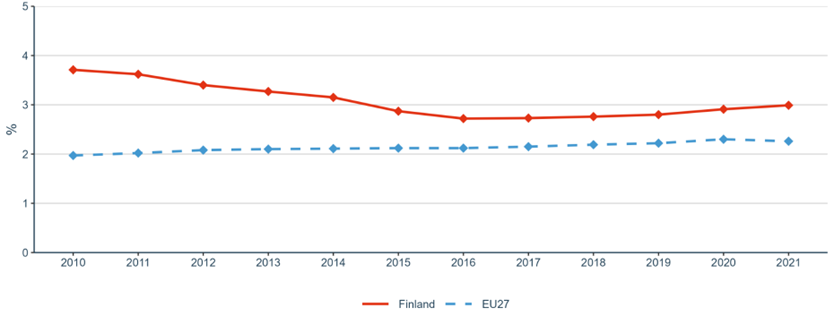

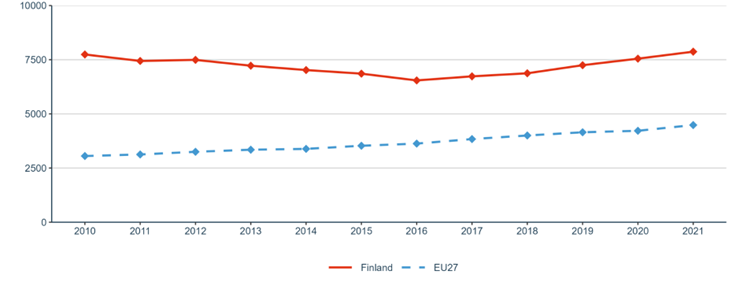
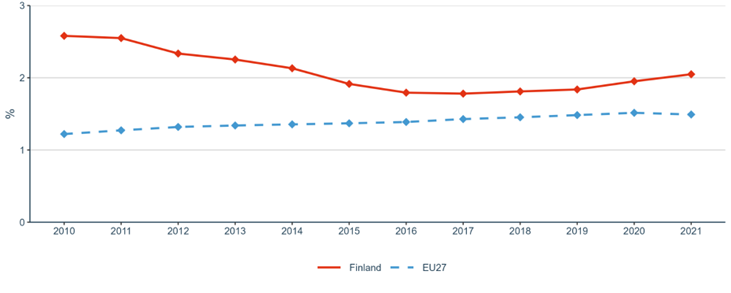
Priority 1: Deepening a truly functioning internal market for knowledge
Sub-priority 1.1: Open Science
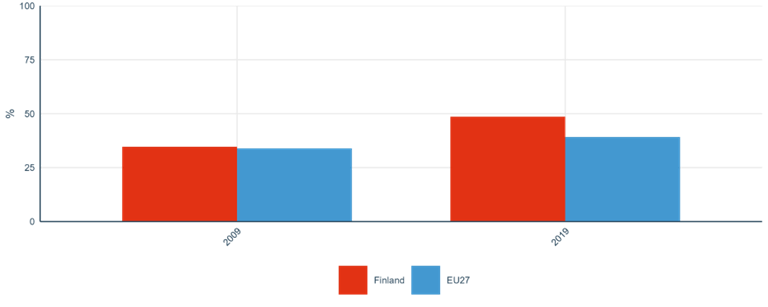
Sub-priority 1.2: Research infrastructures
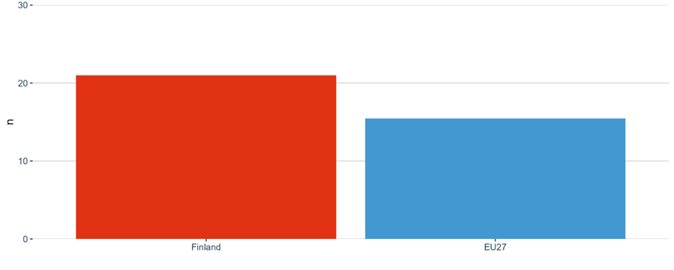
Sub-priority 1.3: Gender equality, equal opportunities for all and inclusiveness

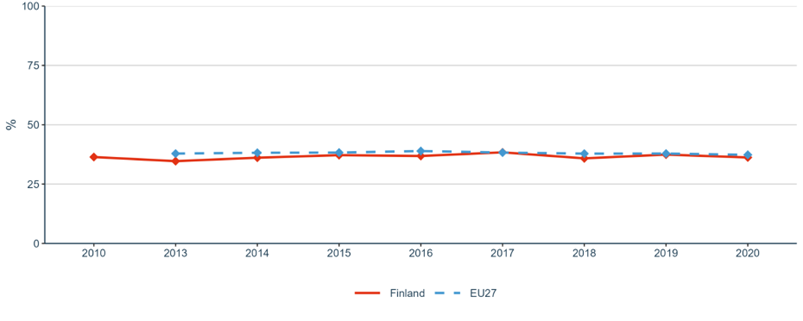
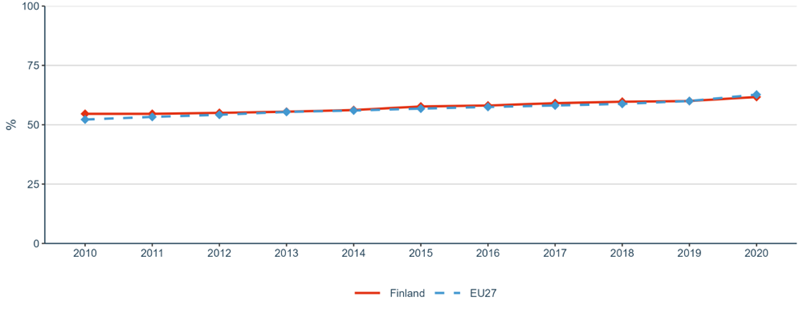

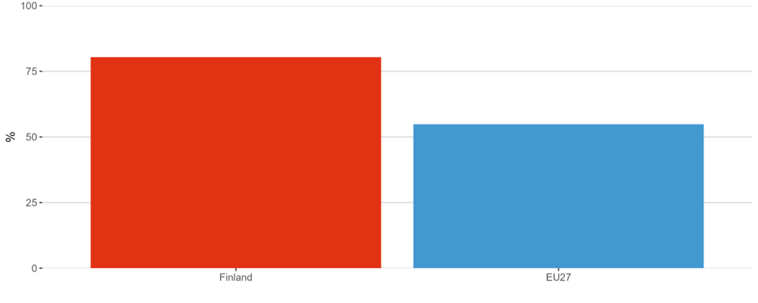
Sub-priority 1.4: Researchers’ careers and mobility and research assessment and reward systems
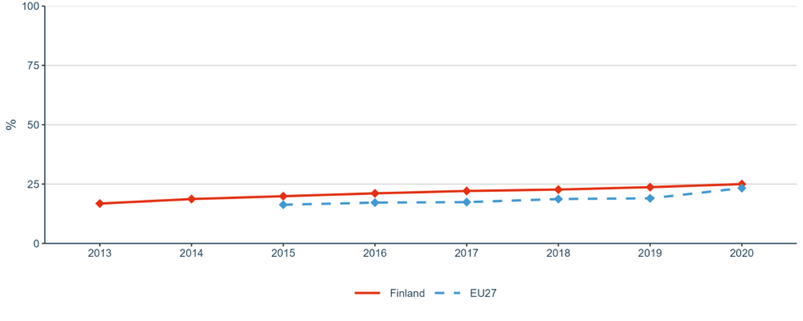


Sub-priority 1.5: Knowledge valorisation
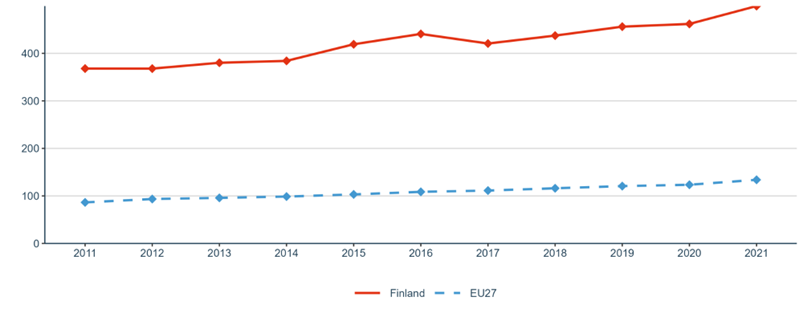
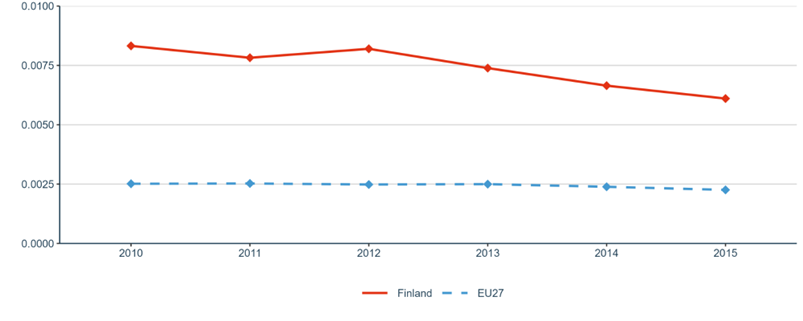
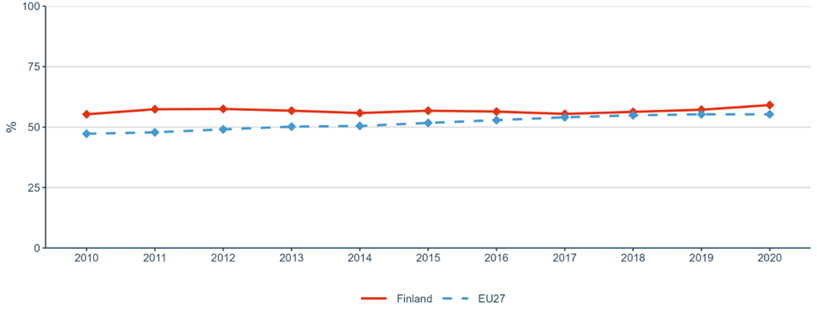
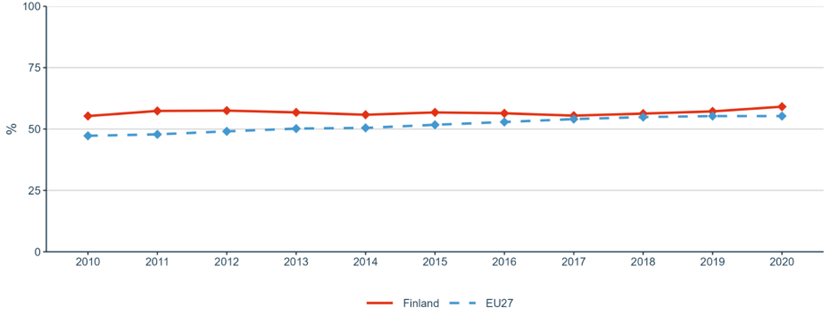
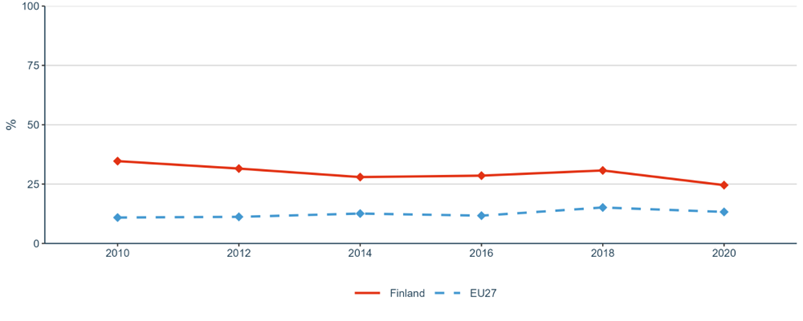
Sub-priority 1.6: Scientific leadership
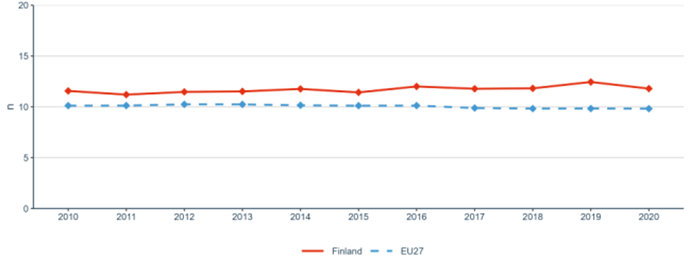

Sub-priority 1.7: Global engagement
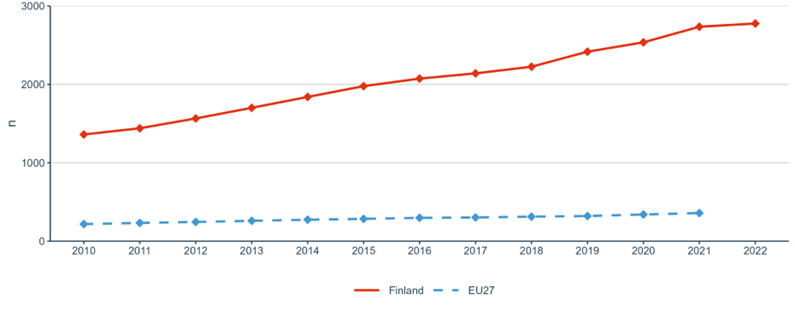

Priority 2: Taking up together the challenges posed by the twin green and digital transition, and increasing society’s participation in the ERA
Sub-priority 2.1: Challenge-based ERA actions

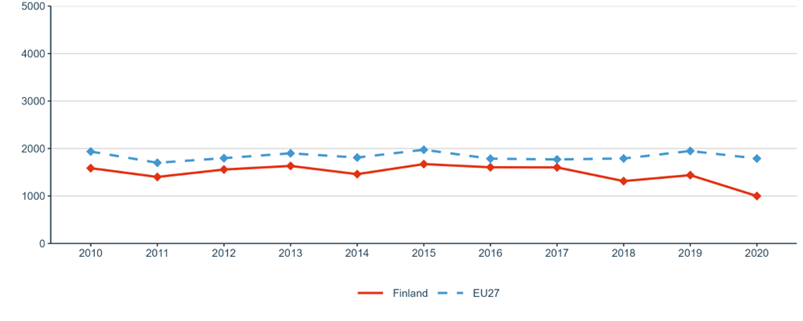

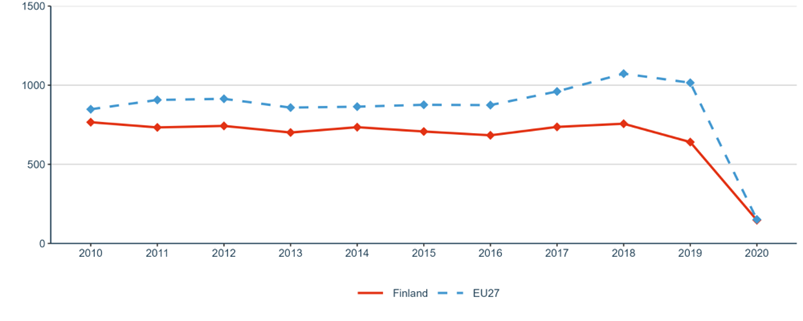

Sub-priority 2.2: Synergies with education and the European Skills Agenda
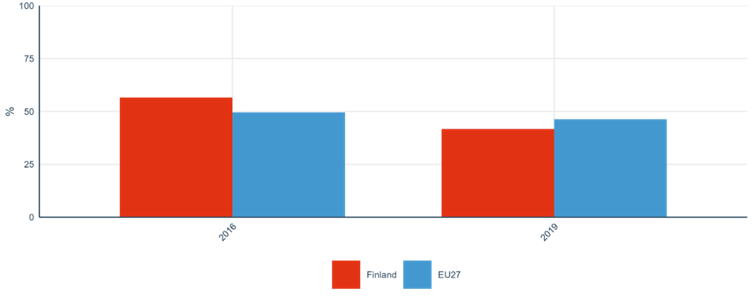
Sub-priority 2.3: Synergies with sectorial policies and industrial policy, in order to boost innovation ecosystems
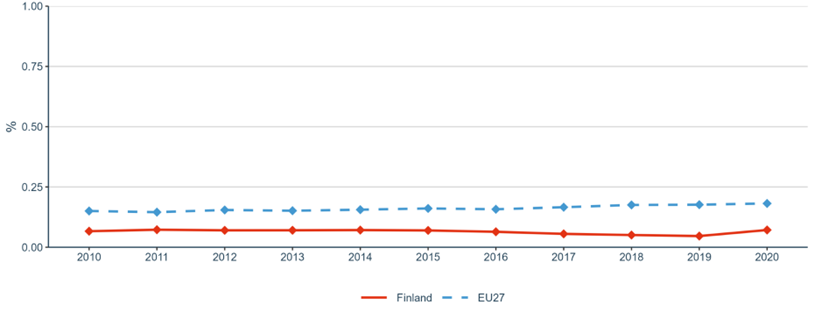
Sub-priority 2.4: An active citizen and societal engagement in R&I in all its dimensions


Priority 3: Amplifying access to research and innovation excellence across the Union
Sub-priority 3.1: More investments and reforms in countries and regions with lower R&I performance
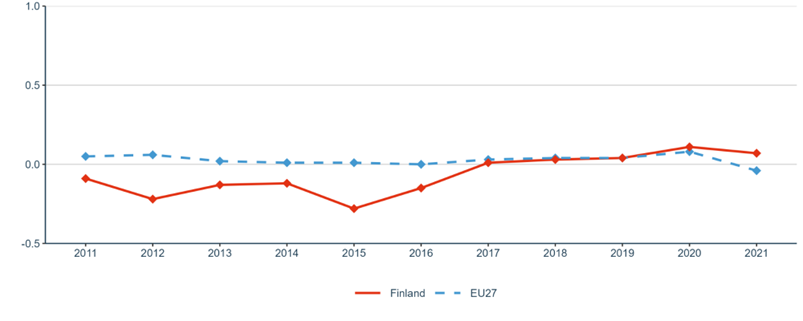
Priority 4: Advancing concerted research and innovation investments and reforms
Sub-priority 4.1: Coordination of R&I investments
